In Situ Tensile Testing under High-Speed Optical Recording to Determine Hierarchical Damage Kinetics in Polymer Layers of Flax Fibre Elements
Abstract
1. Introduction
2. Experimental Layout
2.1. Materials
2.2. Biochemical Composition
- Monosaccharides:
- Lignin:
- Proteins:
2.3. Sample Preparation
2.4. Optical Image Processing
2.5. Standard Tensile Experiments
- Unitary fibre scale:
- Bundle scale:
2.6. In Situ Tensile Experiments
2.7. Scanning Electron Microscopy Observations
3. Results and Discussion
3.1. Biochemical Results
3.2. Overall Mechanical Behaviour
3.3. Defect Analysis Results
3.4. In Situ Mechanical Behaviour at Unitary Fibre Scale
3.5. In Situ Mechanical Behaviour at Bundle Scale
4. Conclusions
Author Contributions
Funding
Institutional Review Board Statement
Data Availability Statement
Acknowledgments
Conflicts of Interest
References
- Rahman, M.Z. Mechanical and damping performances of flax fibre composites—A review. Compos. Part C Open Access 2021, 4, 100081. [Google Scholar] [CrossRef]
- Mohanty, A.K.; Vivekanandhan, S.; Pin, J.-M.; Misra, M. Composites from renewable and sustainable resources: Challenges and innovations. Science 2018, 362, 536–542. [Google Scholar] [CrossRef] [PubMed]
- Baley, C.; Bourmaud, A.; Davies, P. Eighty years of composites reinforced by flax fibres: A historical review. Compos. Part A Appl. Sci. Manuf. 2021, 144, 106333. [Google Scholar] [CrossRef]
- Ray, F.; Evert, S.E.E. Esau’s Plant Anatomy: Meristems, Cells, and Tissues of the Plant Body: Their Structure, Function, and Development, 3rd ed.; Wiley: Hoboken, NJ, USA, 2006; p. 624. [Google Scholar]
- Gorshkova, T.; Brutch, N.; Chabbert, B.; Deyholos, M.; Hayashi, T.; Lev-Yadun, S.; Mellerowicz, E.J.; Morvan, C.; Neutelings, G.; Pilate, G. Plant Fiber Formation: State of the Art, Recent and Expected Progress, and Open Questions. Crit. Rev. Plant Sci. 2012, 31, 201–228. [Google Scholar] [CrossRef]
- Morvan, C.; Andème-Onzighi, C.; Girault, R.; Himmelsbach, D.S.; Driouich, A.; Akin, D.E. Building flax fibres: More than one brick in the walls. Plant Physiol. Biochem. 2003, 41, 935–944. [Google Scholar] [CrossRef]
- Park, Y.B.; Cosgrove, D.J. A revised architecture of primary cell walls based on biomechanical changes induced by substrate-specific endoglucanases. Plant Physiol. 2012, 158, 192880. [Google Scholar] [CrossRef]
- Bourmaud, A.; Beaugrand, J.; Shah, D.U.; Placet, V.; Baley, C. Towards the design of high-performance plant fibre composites. Prog. Mater. Sci. 2018, 97, 347–408. [Google Scholar] [CrossRef]
- Lucas, P.W.; Tan, H.T.W.; Cheng, P.Y. The toughness of secondary cell wall and woody tissue. Philos. Trans. R. Soc. B-Biol. Sci. 1997, 352, 341–352. [Google Scholar]
- Gorshkova, T.A.; Gurjanov, O.P.; Mikshina, P.V.; Ibragimova, N.N.; Mokshina, N.E.; Salnikov, V.V.; Ageeva, M.V.; Amenitskii, S.I.; Chernova, T.E.; Chemikosova, S.B. Specific type of secondary cell wall formed by plant fibers. Russ. J. Plant Physiol. 2010, 57, 328–341. [Google Scholar] [CrossRef]
- Thomason, J.L.; Carruthers, J.; Kelly, J.; Johnson, G. Fibre cross-section determination and variability in sisal and flax and its effects on fibre performance characterisation. Compos. Sci. Technol. 2011, 71, 1008–1015. [Google Scholar] [CrossRef]
- Melelli, A.; Durand, S.; Alvarado, C.; Kervoëlen, A.; Foucat, L.; Grégoire, M.; Arnould, O.; Falourd, X.; Callebert, F.; Ouagne, P.; et al. Anticipating global warming effects: A comprehensive study of drought impact of both flax plants and fibres. Ind. Crops Prod. 2022, 184, 115011. [Google Scholar] [CrossRef]
- Khadka, B.; Cloutier, S. Genetics of Abiotic Stress in Flax. In The Flax Genome; You, F.M., Fofana, B., Eds.; Springer International Publishing: Cham, Switzerland, 2023; pp. 101–120. [Google Scholar] [CrossRef]
- Guo, D.; Jiang, H.; Ye, J.; Zhang, A.; Wang, Y.; Gao, Y.; Yan, Q.; Chen, J.; Duan, L.; Liu, H.; et al. Transcriptome combined with population level validation reveals genomic loci controlling plant height in flax (Linum usitatissimum L.). Ind. Crops Prod. 2021, 172, 113998. [Google Scholar] [CrossRef]
- Chabi, M.; Goulas, E.; Leclercq, C.C.; de Waele, I.; Rihouey, C.; Cenci, U.; Day, A.; Blervacq, A.S.; Neutelings, G.; Duponchel, L.; et al. A Cell Wall Proteome and Targeted Cell Wall Analyses Provide Novel Information on Hemicellulose Metabolism in Flax. Mol. Cell. Proteom. 2017, 16, 1634–1651. [Google Scholar] [CrossRef]
- Hernandez-Estrada, A.; Reza, M.; Hughes, M. The structure of dislocations in hemp (Cannabis sativa L.) fibres and implications for mechanical behaviour. BioResources 2020, 15, 2579–2595. [Google Scholar] [CrossRef]
- Thygesen, L.G.; Gierlinger, N. The molecular structure within dislocations in Cannabis sativa fibres studied by polarised Raman microspectroscopy. J. Struct. Biol. 2013, 182, 219–225. [Google Scholar] [CrossRef]
- Bourmaud, A.; Pinsard, L.; Guillou, E.; De Luycker, E.; Fazzini, M.; Perrin, J.; Weitkamp, T.; Ouagne, P. Elucidating the formation of structural defects in flax fibres through synchrotron X-ray phase-contrast microtomography. Ind. Crops Prod. 2022, 184, 115048. [Google Scholar] [CrossRef]
- Madsen, B.; Aslan, M.; Lilholt, H. Fractographic observations of the microstructural characteristics of flax fibre composites. Compos. Sci. Technol. 2016, 123, 151–162. [Google Scholar] [CrossRef]
- Hanninen, T.; Thygesen, A.; Mehmood, S.; Madsen, B.; Hughes, M. Mechanical processing of bast fibres: The occurrence of damage and its effect on fibre structure. Ind. Crops Prod. 2012, 39, 7–11. [Google Scholar] [CrossRef]
- Madsen, B.; Thygesen, A.; Lilholt, H. Plant fibre composites—porosity and stiffness. Compos. Sci. Technol. 2009, 69, 1057–1069. [Google Scholar] [CrossRef]
- Richely, E.; Nuez, L.; Pérez, J.; Rivard, C.; Baley, C.; Bourmaud, A.; Guessasma, S.; Beaugrand, J. Influence of defects on the tensile behaviour of flax fibres: Cellulose microfibrils evolution by synchrotron X-ray diffraction and finite element modelling. Compos. Part C Open Access 2022, 100300. [Google Scholar]
- Nilsson, T.; Gustafsson, P.J. Influence of dislocations and plasticity on the tensile behaviour of flax and hemp fibres. Compos. Part A Appl. Sci. Manuf. 2007, 38, 1722–1728. [Google Scholar] [CrossRef]
- Fuentes, C.A.; Willekens, P.; Petit, J.; Thouminot, C.; Müssig, J.; Trindade, L.M.; Van Vuure, A.W. Effect of the middle lamella biochemical composition on the non-linear behaviour of technical fibres of hemp under tensile loading using strain mapping. Compos. Part A Appl. Sci. Manuf. 2017, 101, 529–542. [Google Scholar] [CrossRef]
- Lawrence Sy, B.; Oguamanam, D.; Bougherara, H. Impact response of a new kevlar/flax/epoxy hybrid composite using infrared thermography and high-speed imaging. Compos. Struct. 2022, 280, 114885. [Google Scholar] [CrossRef]
- Charlet, K.; Béakou, A. Mechanical properties of interfaces within a flax bundle—Part I: Experimental analysis. Int. J. Adhes. Adhes. 2011, 31, 875–881. [Google Scholar] [CrossRef]
- Puech, L.; Ram Ramakrishnan, K.; Le Moigne, N.; Corn, S.; Slangen, P.R.; Le Duc, A.; Boudhani, H.; Bergeret, A. Investigating the impact behaviour of short hemp fibres reinforced polypropylene biocomposites through high speed imaging and finite element modelling. Compos. Part A Appl. Sci. Manuf. 2018, 109, 428–439. [Google Scholar] [CrossRef]
- Romhany, G.; Karger-Kocsis, J.; Czigany, T. Tensile Fracture and Failure Behavior of Technical Flax Fibers. J. Appl. Polym. Sci. 2003, 90, 3638–3645. [Google Scholar]
- Thygesen, A.; Madsen, B.; Bjerre, A.B.; Lilholt, H. Cellulosic Fibers: Effect of Processing on Fiber Bundle Strength. J. Nat. Fibers 2011, 8, 161–175. [Google Scholar] [CrossRef]
- Barbulée, A.; Jernot, J.-P.; Bréard, J.; Gomina, M. Damage to flax fibre slivers under monotonic uniaxial tensile loading. Compos. Part A Appl. Sci. Manuf. 2014, 64, 107–114. [Google Scholar] [CrossRef]
- Ahmed, S.; Ulven, C. Dynamic In-Situ Observation on the Failure Mechanism of Flax Fiber through Scanning Electron Microscopy. Fibers 2018, 6, 17. [Google Scholar] [CrossRef]
- Mott, L.; Shaler, S.M.; Groom, L.; Liang, B. The tensile testing of individual wood fibers using environmental scanning electron microscopy and video image analysis. Tappi J. 1995, 78, 143–148. [Google Scholar]
- Baley, C. Influence of kink bands on the tensile strength of flax fibers. J. Mater. Sci. 2004, 39, 331–334. [Google Scholar] [CrossRef]
- Aslan, M.; Chinga-Carrasco, G.; Sørensen, B.F.; Madsen, B. Strength variability of single flax fibres. J. Mater. Sci. 2011, 46, 6344–6354. [Google Scholar] [CrossRef]
- Beaugrand, J.; Guessasma, S. Scenarios of crack propagation in bast fibers: Combining experimental and finite element approaches. Compos. Struct. 2015, 133, 667–678. [Google Scholar] [CrossRef]
- Silva, F.d.A.; Zhu, D.; Mobasher, B.; Soranakom, C.; Toledo Filho, R.D. High speed tensile behavior of sisal fiber cement composites. Mater. Sci. Eng. A 2010, 527, 544–552. [Google Scholar] [CrossRef]
- Blakeney, A.B.; Harris, P.J.; Henry, R.J.; Stone, B.A. A simple and rapid preparation of alditol acetates for monosaccharide analysis. Carbohydr. Res. 1983, 113, 291–299. [Google Scholar] [CrossRef]
- Thibault, J.F. Automatisation du dosage des substances pectiques par la methode au meta-hydroxydiphenyl. Lebensm.-Wiss. Technol. Food Sci. Technol. 1979, 12, 247–251. [Google Scholar]
- Hatfield, R.; Fukushima, R.S. Can Lignin Be Accurately Measured? Crop Sci. 2005, 45, 832–839. [Google Scholar] [CrossRef]
- Mariotti, F.; Tomé, D.; Mirand, P. Converting Nitrogen into Protein—Beyond 6.25 and Jones’ Factors. Crit. Rev. Food Sci. Nutr. 2008, 48, 177–184. [Google Scholar]
- Turek, D.E. On the tensile testing of high modulus polymers and the compliance correction. Polym. Eng. Sci. 1993, 33, 328–333. [Google Scholar]
- Richely, E.; Bourmaud, A.; Placet, V.; Guessasma, S.; Beaugrand, J. A critical review of the ultrastructure, mechanics and modelling of flax fibres and their defects. Prog. Mater. Sci. 2021, 124, 100851. [Google Scholar] [CrossRef]
- Roach, M.J.; Mokshina, N.Y.; Badhan, A.; Snegireva, A.V.; Hobson, N.; Deyholos, M.K.; Gorshkova, T.A. Development of cellulosic secondary walls in flax fibers requires beta-galactosidase. Plant Physiol. 2011, 156, 1351–1363. [Google Scholar] [CrossRef]
- Chemikosova, S.B.; Pavlencheva, N.V.; Gur’yanov, O.P.; Gorshkova, T.A. The effect of soil drought on the phloem fiber development in long-fiber flax. Russ. J. Plant Physiol. 2006, 53, 656–662. [Google Scholar] [CrossRef]
- Gautreau, M.; Durand, S.; Paturel, A.; Le Gall, S.; Foucat, L.; Falourd, X.; Novales, B.; Ralet, M.-C.; Chevallier, S.; Kervoelen, A.; et al. Impact of cell wall non-cellulosic and cellulosic polymers on the mechanical properties of flax fibre bundles. Carbohydr. Polym. 2022, 291, 119599. [Google Scholar] [CrossRef]
- Faruk, O.; Bledzki, A.K.; Fink, H.-P.; Sain, M. Biocomposites reinforced with natural fibers: 2000–2010. Prog. Polym. Sci. 2012, 37, 1552–1596. [Google Scholar] [CrossRef]
- Frei, M. Lignin: Characterization of a multifaceted crop component. Sci. World J. 2013, 2013, 436517. [Google Scholar] [CrossRef]
- Cabane, M.; Afif, D.; Hawkins, S. Lignins and abiotic stresses. In Advances in Botanical Research; Elsevier: Amsterdam, The Netherlands, 2012; Volume 61, pp. 219–262. [Google Scholar]
- Akin, D.E.; Gamble, G.R.; Morrison, W.H.; Rigsby, L. Chemical and Structural Analysis of Fibre and Core Tissues from Flax. J. Sci. Food Agric. 1996, 72, 155–165. [Google Scholar] [CrossRef]
- Gorshkova, T. Composition and Distribution of Cell Wall Phenolic Compounds in Flax (Linum usitatissimum L.) Stem Tissues. Ann. Bot. 2000, 85, 477–486. [Google Scholar] [CrossRef]
- Corbin, C.; Drouet, S.; Markulin, L.; Auguin, D.; Lainé, É.; Davin, L.B.; Cort, J.R.; Lewis, N.G.; Hano, C. A genome-wide analysis of the flax (Linum usitatissimum L.) dirigent protein family: From gene identification and evolution to differential regulation. Plant Mol. Biol. 2018, 97, 73–101. [Google Scholar]
- Baley, C.; Bourmaud, A. Average tensile properties of French elementary flax fibers. Mater. Lett. 2014, 122, 159–161. [Google Scholar] [CrossRef]
- Griffith, A.A. The phenomena of rupture and flow in solids. Philos. Trans. R. Soc. Lond. 1921, 221, 163–198. [Google Scholar]
- Alix, S.; Lebrun, L.; Marais, S.; Philippe, E.; Bourmaud, A.; Baley, C.; Morvan, C. Pectinase treatments on technical fibres of flax: Effects on water sorption and mechanical properties. Carbohydr. Polym. 2012, 87, 177–185. [Google Scholar] [CrossRef] [PubMed]
- Barbulee, A.; Gomina, M. Variability of the mechanical properties among flax fiber bundles and strands. Procedia Eng. 2017, 200, 487–493. [Google Scholar]
- Garat, W.; Corn, S.; Le Moigne, N.; Beaugrand, J.; Bergeret, A. Analysis of the morphometric variations in natural fibres by automated laser scanning: Towards an efficient and reliable assessment of the cross-sectional area. Compos. Part A Appl. Sci. Manuf. 2018, 108, 114–123. [Google Scholar] [CrossRef]
- Summerscales, J.; Virk, A.S.; Hall, W. Fibre area correction factors (FACF) for the extended rules-of-mixtures for natural fibre reinforced composites. Mater. Today Proc. 2020, 31, S318–S320. [Google Scholar] [CrossRef]
- Beaugrand, J.; Guessasma, S.; Maigret, J.E. Damage mechanisms in defected natural fibers. Sci. Rep. 2017, 7, 14041. [Google Scholar] [CrossRef]
- Richely, E.; Durand, S.; Melelli, A.; Kao, A.; Magueresse, A.; Dhakal, H.; Gorshkova, T.; Callebert, F.; Bourmaud, A.; Beaugrand, J.; et al. Novel Insight into the Intricate Shape of Flax Fibre Lumen. Fibers 2021, 9, 24. [Google Scholar] [CrossRef]
- Melelli, A.; Jamme, F.; Legland, D.; Beaugrand, J.; Bourmaud, A. Microfibril angle of elementary flax fibres investigated with polarised second harmonic generation microscopy. Ind. Crops Prod. 2020, 156, 112847. [Google Scholar] [CrossRef]
- Péron, M.; Célino, A.; Castro, M.; Jacquemin, F.; Le Duigou, A. Study of hygroscopic stresses in asymmetric biocomposite laminates. Compos. Sci. Technol. 2019, 169, 7–15. [Google Scholar] [CrossRef]
- Bos, H. The Potential of Flax Fibres as Reinforcement for Composite Materials. Ph.D. Thesis, Technische Universiteit Eindhoven, Eindhoven, The Netherlands, 2004. [Google Scholar]
- Lu, M.M.; Fuentes, C.A.; Van Vuure, A.W. Moisture sorption and swelling of flax fibre and flax fibre composites. Compos. Part B Eng. 2021, 231, 109538. [Google Scholar] [CrossRef]
- Moudood, A.; Rahman, A.; Öchsner, A.; Islam, M.; Francucci, G. Flax fiber and its composites: An overview of water and moisture absorption impact on their performance. J. Reinf. Plast. Compos. 2018, 38, 323–339. [Google Scholar] [CrossRef]
- El Hachem, Z.; Célino, A.; Challita, G.; Moya, M.-J.; Fréour, S. Hygroscopic multi-scale behavior of polypropylene matrix reinforced with flax fibers. Ind. Crops Prod. 2019, 140, 111634. [Google Scholar] [CrossRef]
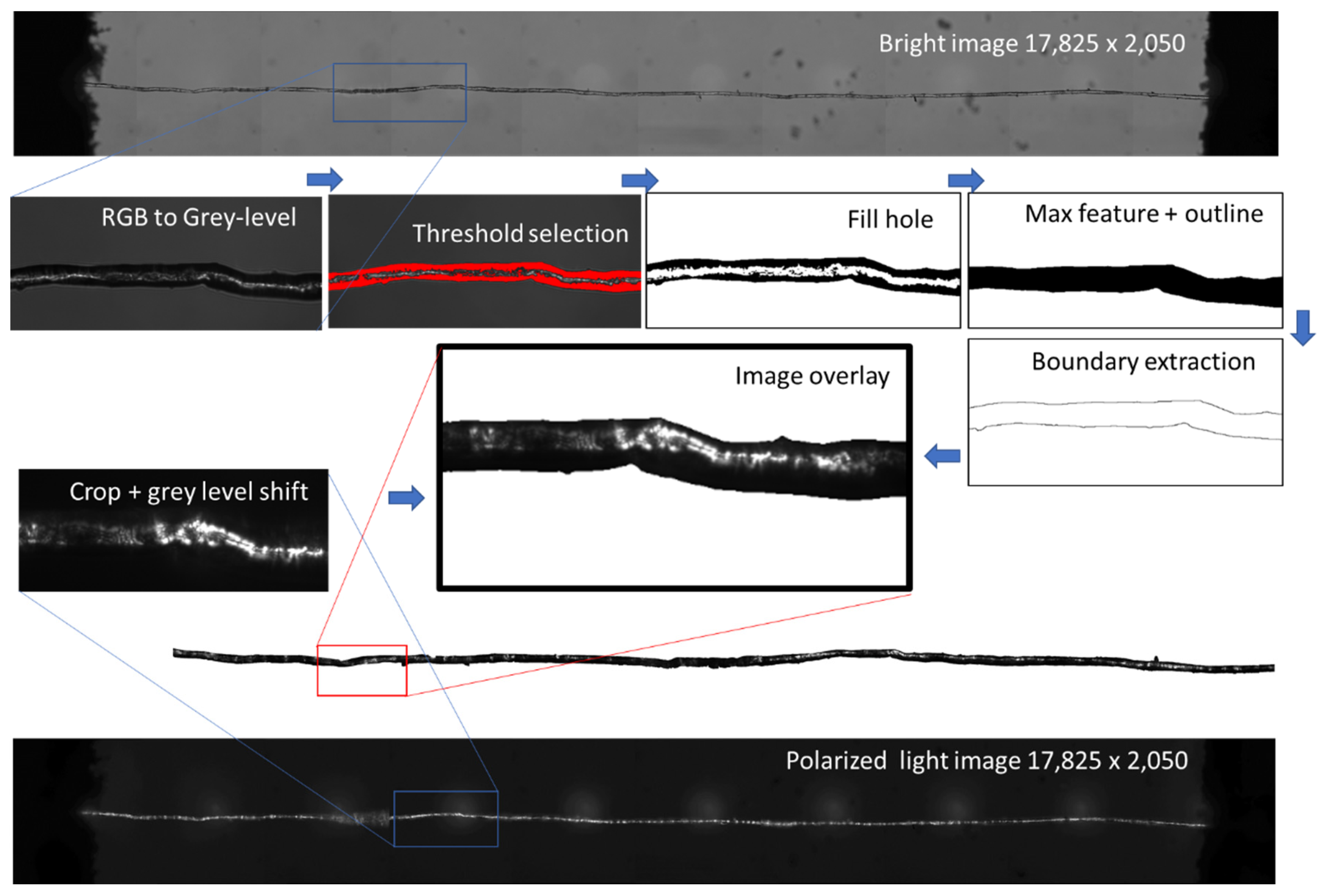

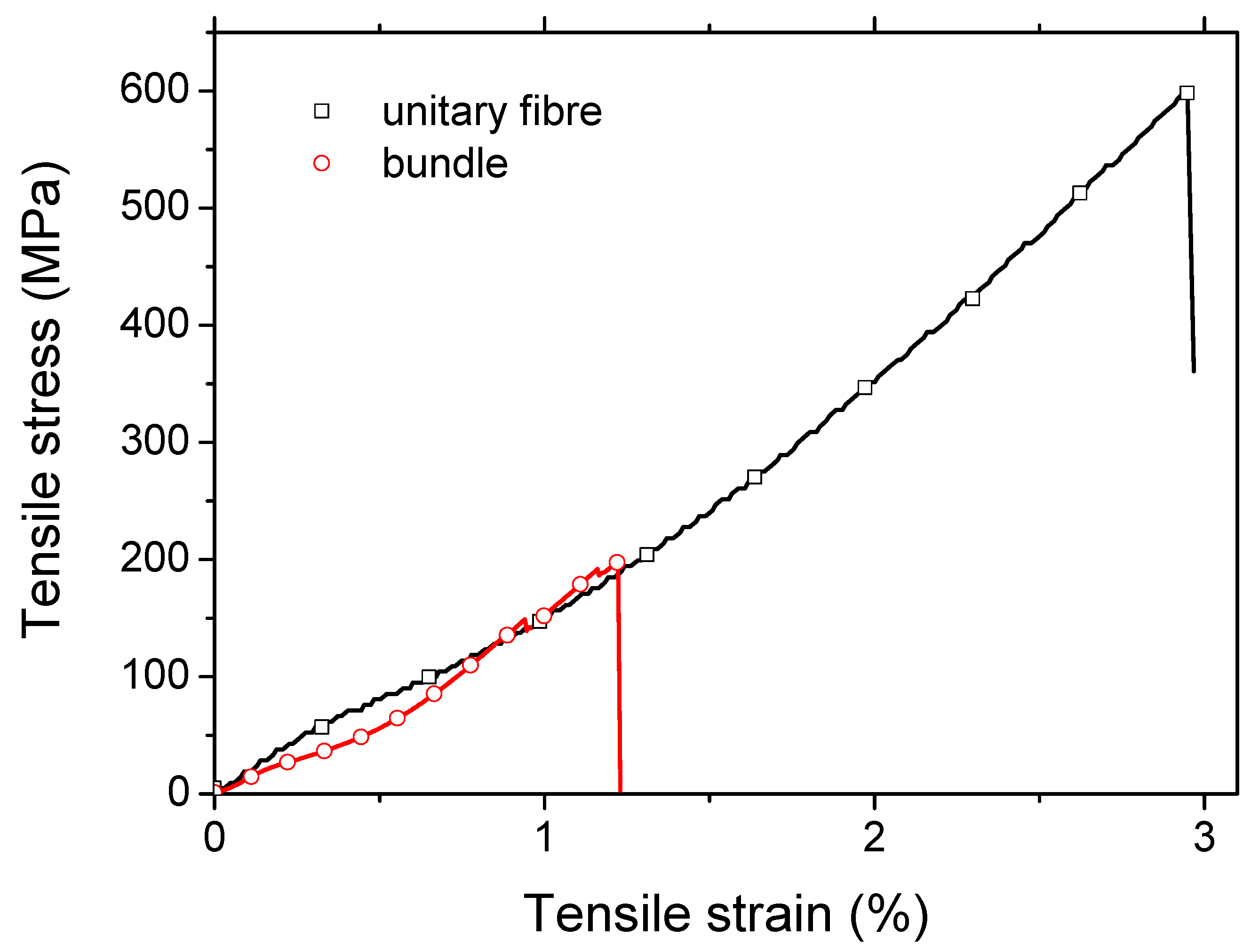
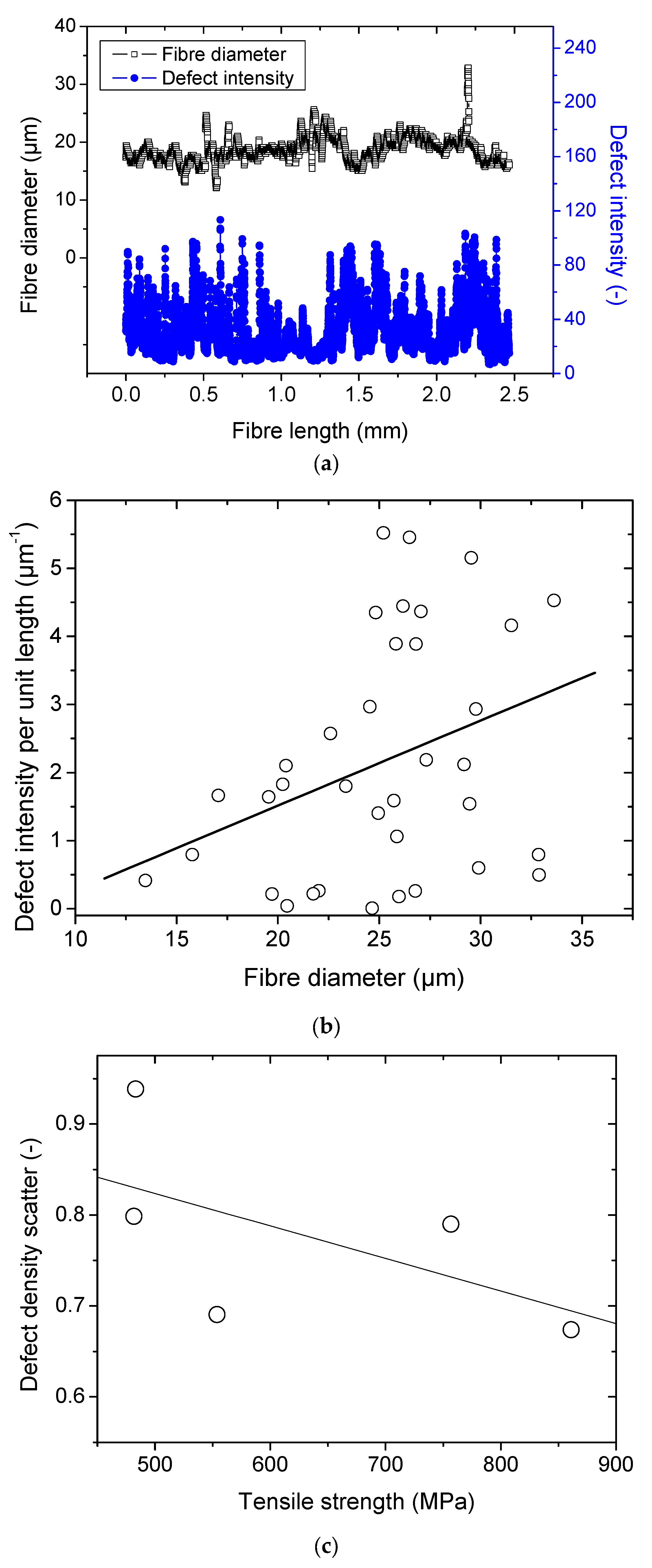



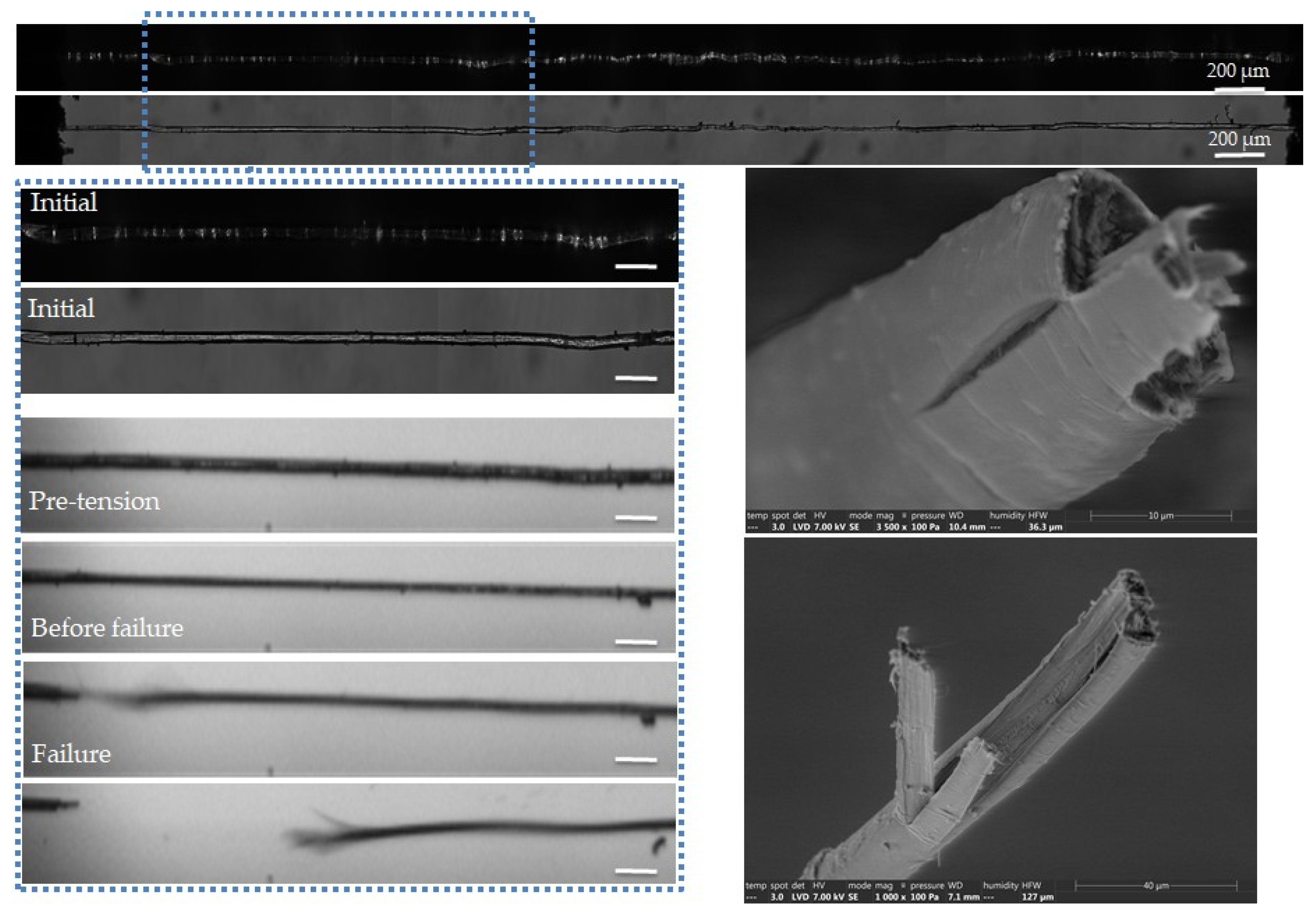


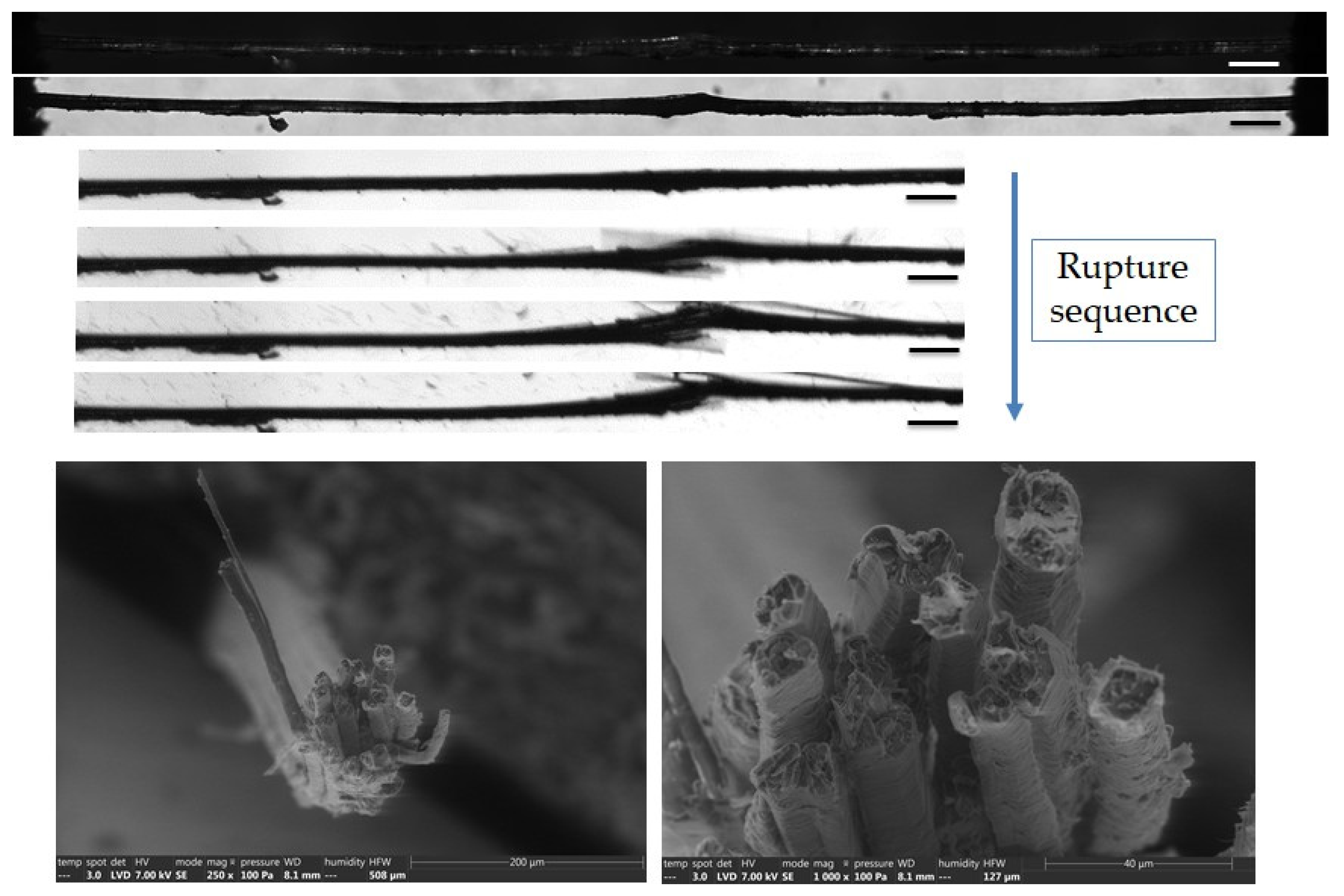
| Sample | Recording Speed (fps) | ROI Size (pix.) | Strength (MPa) | Elongation at Break (%) |
|---|---|---|---|---|
| b-1-41 | 100,000 | 704 × 48 | 403 | 1.80 |
| a-1-10 | 108,000 | 1024 × 48 | 757 | 3.19 |
| a-1-11 | 557 | 3.76 | ||
| b-1-37 | 794 | 3.45 | ||
| a-1-12 | 150,000 | 1024 × 32 | 482 | 3.60 |
| a-1-13 | 875 | 1.79 | ||
| a-1-14 | 554 | 2.78 | ||
| a-1-22 | 483 | 3.97 | ||
| a-1-16 | 852 | 1.59 | ||
| a-1-18 | 861 | 3.57 | ||
| a-1-20 | 270,000 | 1024 × 16 | 462 | 0.80 |
| a-1-24 | 595 | 1.39 | ||
| a-1-26 | 741.3 | 4.17 | ||
| Mean values for unitary fibres | - | - | 656 ± 164 | 2.78 ± 1.18 |
Disclaimer/Publisher’s Note: The statements, opinions and data contained in all publications are solely those of the individual author(s) and contributor(s) and not of MDPI and/or the editor(s). MDPI and/or the editor(s) disclaim responsibility for any injury to people or property resulting from any ideas, methods, instructions or products referred to in the content. |
© 2023 by the authors. Licensee MDPI, Basel, Switzerland. This article is an open access article distributed under the terms and conditions of the Creative Commons Attribution (CC BY) license (https://creativecommons.org/licenses/by/4.0/).
Share and Cite
Richely, E.; Beaugrand, J.; Coret, M.; Binetruy, C.; Ouagne, P.; Bourmaud, A.; Guessasma, S. In Situ Tensile Testing under High-Speed Optical Recording to Determine Hierarchical Damage Kinetics in Polymer Layers of Flax Fibre Elements. Polymers 2023, 15, 2794. https://doi.org/10.3390/polym15132794
Richely E, Beaugrand J, Coret M, Binetruy C, Ouagne P, Bourmaud A, Guessasma S. In Situ Tensile Testing under High-Speed Optical Recording to Determine Hierarchical Damage Kinetics in Polymer Layers of Flax Fibre Elements. Polymers. 2023; 15(13):2794. https://doi.org/10.3390/polym15132794
Chicago/Turabian StyleRichely, Emmanuelle, Johnny Beaugrand, Michel Coret, Christophe Binetruy, Pierre Ouagne, Alain Bourmaud, and Sofiane Guessasma. 2023. "In Situ Tensile Testing under High-Speed Optical Recording to Determine Hierarchical Damage Kinetics in Polymer Layers of Flax Fibre Elements" Polymers 15, no. 13: 2794. https://doi.org/10.3390/polym15132794
APA StyleRichely, E., Beaugrand, J., Coret, M., Binetruy, C., Ouagne, P., Bourmaud, A., & Guessasma, S. (2023). In Situ Tensile Testing under High-Speed Optical Recording to Determine Hierarchical Damage Kinetics in Polymer Layers of Flax Fibre Elements. Polymers, 15(13), 2794. https://doi.org/10.3390/polym15132794












